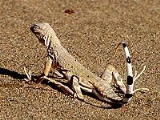
Zebra-tailed lizard
Overview
Genus
In biology, a genus is a low-level taxonomic rank used in the biological classification of living and fossil organisms, which is an example of definition by genus and differentia...
of phrynosomatid
Phrynosomatidae
Phrynosomatidae is a diverse family of lizards, found from Panama to the extreme south of Canada. Many members of the group are adapted to life in hot, sandy deserts, although the spiny lizards prefer rocky deserts or even relatively moist forest edges, and the short-horned lizard lives in prairie...
lizard
Lizard
Lizards are a widespread group of squamate reptiles, with nearly 3800 species, ranging across all continents except Antarctica as well as most oceanic island chains...
s endemic to the southwestern United States
United States
The United States of America is a federal constitutional republic comprising fifty states and a federal district...
and northwestern Mexico
Mexico
The United Mexican States , commonly known as Mexico , is a federal constitutional republic in North America. It is bordered on the north by the United States; on the south and west by the Pacific Ocean; on the southeast by Guatemala, Belize, and the Caribbean Sea; and on the east by the Gulf of...
.
They live in open desert
Desert
A desert is a landscape or region that receives an extremely low amount of precipitation, less than enough to support growth of most plants. Most deserts have an average annual precipitation of less than...
with fairly hard-packed soil, scattered vegetation and scattered rocks, typically desert flats, washes and plain
Plain
In geography, a plain is land with relatively low relief, that is flat or gently rolling. Prairies and steppes are types of plains, and the archetype for a plain is often thought of as a grassland, but plains in their natural state may also be covered in shrublands, woodland and forest, or...
s.
They range in size from 2.5 to 4 in (63.5 to 101.6 mm) in snout to vent length (SVL).
These lizards are grey to sandy brown, usually with series of paired dark gray spots down the back, becoming black bands on the tail.

